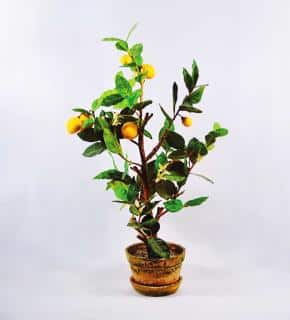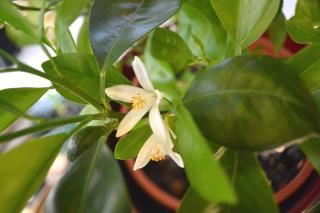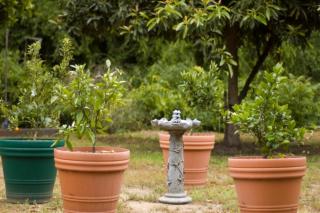

Potted orange is an excellent citrus tree to grow in a pot on a balcony or on a terrace. Caring for this container-grown citrus, from re-potting to pruning helps boost orange harvest and prevents appearance of diseases.
Although the climate in most of our regions isn’t well suited to growing orange trees directly in the ground, growing them in pots is perfectly possible.
Discover:
Potted orange trees cannot extract the nutrients they need from the ground.

Repotting the orange tree is thus of critical importance.
Pruning isn’t really needed but if you don’t prune your orange tree, it will quickly grow very large.
In pots, it is best to control your tree’s growth with very regular pruning.
Shorten each new shoot back to more or less half its length, taking great care to cut just above a leaf.
This will result in your orange tree keeping a nice, tight shape.
You might need to do this several times a year.
Eliminate dead wood regularly and if possible, clear the inside of your fruit tree to let light penetrate to the center.

In summer, frequent watering is required whereas in winter, it is enough to simply reduce the number of watering rounds.
Every two weeks, during the growth phase, add citrus-specific fertilizer to boost fruit-bearing.

Orange trees aren’t indoor plants, and can’t bear staying in a heated environment all year round.
They need relatively lower temperatures from October to May.
If you’re looking for an indoor orange tree, choose calamondin instead.
This means it is important to place your orange tree in a non-heated greenhouse or lean-in, where the temperature never drops below 32°F (0°C).

So you’ll be ripening your oranges while your tree is kept from freezing and the soil is kept slightly moist.
Since the air inside homes tends to be rather dry, make sure you water regularly: if not, your fruits will be bland and not very juicy.
Pick the oranges as soon as they easily break off from their branch.
I have an orange tree (in house potted) that has only 2 stalks that are continuously growing higher.
Should I cut them right down to 1/2?
Yes, you can cut them back by half. They’ll each branch out into two or more branches, off to the side. Check out “eyes” on the stem, where leaves used to be: the ones nearest the cut will likely sprout strongest. Place your cut so that these topmost eyes are set in the right direction: towards the outside of the pot, not facing inwards. But you can always adjust later by pinching off those new shoots you don’t want to turn into branches.
I live in NC and have a potted orange tree. I’ve had it for three years and it has done well on our screened porch. However this winter is first time we did not bring it inside at all due to its size. It is near March and the tree seems stressed for the first time with some dried up and curling leaves. I assumed it was drying out. Not sure if it is too early to fertilize. What do you recommend?
Hi Michele, if this is the first time it has had to overwinter out in the open, then it might have suffered from freezing or frost. On a porch, it rarely freezes but out in a garden, temperatures are easily 5 or 10 degrees colder.
Spring reveals which twigs and branches have suffered from the freezing. Normally, ends of branches suffer most. If the issue is really freeze damage, then you’ll see a clear difference between dying portions and healthy ones: after a certain point, leaves and twigs dry out and fall, whereas before that point, buds form and start growing again. There isn’t much to do than wait it out and see which portions need to be pruned off because they’re dead.
It might be other things: since it’s outside in a more windy location, perhaps the pot dries out faster than before. If the soil is dry even at a finger’s depth, go ahead and water with small amounts. After a few waterings, you can start fertilizing again for the spring season.
Thanks for your feedback. I finally got photos for you. I would appreciate any advice on pruning. Based on what you said, it could definitely be wind damage as one side is hurting more than the other side that is more sheltered. I was throwing a blanket on frosty nights but realized it was t really freezing due to the protection of the screening. I am concerned with overwatering though it seems maybe I should be watering it a lot (daily almost) during dry spells even when it’s cold.
Thanks for sharing your pictures, they’re clear and they show much hope. I say this because though it’s true some leaves are dying off, others seem perfectly healthy.
Normally the tree should quickly sort out which leaves/twigs to keep and which ones to shed. When it’s more clear, you can proceed with pruning, removing dead wood. If in doubt, scratch the bark off, just a sliver: if it’s still green underneath, let it be, since it might send up new buds.
Regarding overwatering: don’t water too much! It will further weaken the tree at this stage. To check whether you need to water, stick your finger about two knuckles deep. If it isn’t dusty-dry, don’t water yet. This is especially important when the weather is cold! In cold weather, sap doesn’t circulate and the whole plant is dormant (even in the sun). Water around the roots will simply sit there and start rotting (that’s when germs like phytphthora strike, responsible for citrus root rot).
I live in S.C. and bought a very small orange tree in FL several years ago. I have repotted it and it doesn’t seem to grow height wise but bushy, I just picked over a hundred baby oranges off it hoping for growth to go to tree and not fruit. Is that correct?
Hi Angela! I used to live in SC, great place to be! You are correct in thinking that removing baby fruits will help the tree grow more “wood” and branches. It’s ok to leave a few for you to have a taste of your tree, though. Remember to fertilize your tree. Try to select a fertilizer that has a bit less nitrogen (N) and more phosphorus (P) and potassium (K). The first really triggers leaf growth whereas P and K help the plant grow roots, wood and other more complex compounds. A great option is to make weed tea (here are the best ones) and use it sparingly over the winter, a bit more beginning of spring and full blast in the middle of spring once blooming has started.
Note that weed tea is quite the stinker, so for indoor pots only use tiny amounts and dilute it well, especially at first. As time passes, bacteria and microorganisms will break the stench down faster and faster, all the while feeding the orange tree very well!
I will be living in the Phoenix, AZ area Oct – April and my home will be vacant during the hot summer months. I’m not sure what to do about a potted orange tree when I’m gone! I could have a neighbor come to water in the front yard if I put it out there…how often? Any other ideas?
Hi Wendy, hmm there are several things you can do to make sure it survives. First of all, it’s really nice that your neighbor will help out. I think at the beginning it’s great if he or she can come twice a week, for instance every 3 days, and after three or four times it’ll be clear whether to extend or shorten the interval. The key is to stick a finger in the soil and feel for moisture. If it feels dusty dry, more often! If still wet and stains fingers, wait another day or two. The trap is to not overwater though, so watering every day is out of the question.
As a preparation to extend watering intervals, here are a few tips:
– if the pot is terra cotta, wrap it with plastic wrap or a tarpaulin to lock moisture in. Terra cotta leaches water very quickly.
– try placing the plant where it only gets sun for like two hours early morning (6 to 8 am) or in the evening (8-10 pm). This will protect it from dehydration if water lacks. The corner of a patio or the protection of a tree might do the trick.
– look into hydrobeads to soak up water and release it when needed. For this you’d have to add them deep into the soil, or repot the tree and mix it into the potting mix.
– atop the soil around the trunk, remember to spread mulch. Make the layer at least 1 inch thick. When checking for moisture, sweep the mulch aside.
– lastly, keep the air moist around the tree with a wide bed of leca balls under the pot. This is excellent for preserving moisture in the air.
Like your article I have a orange tree that my husband trimmed when transplanted this spring but it now June 22nd looks like a bush. How can we prune it? I am afraid to cut the wrong branches I can send you a photo if you can give us advice. Thanks
Sure!